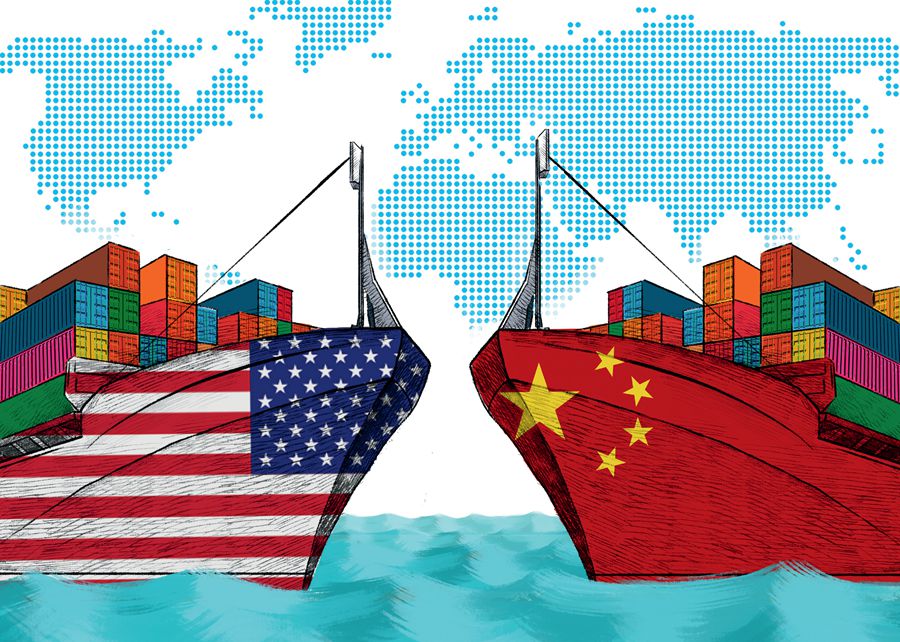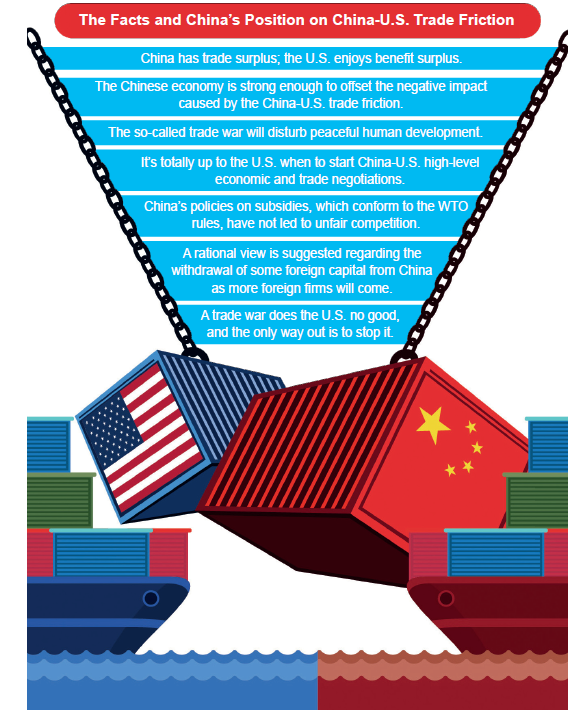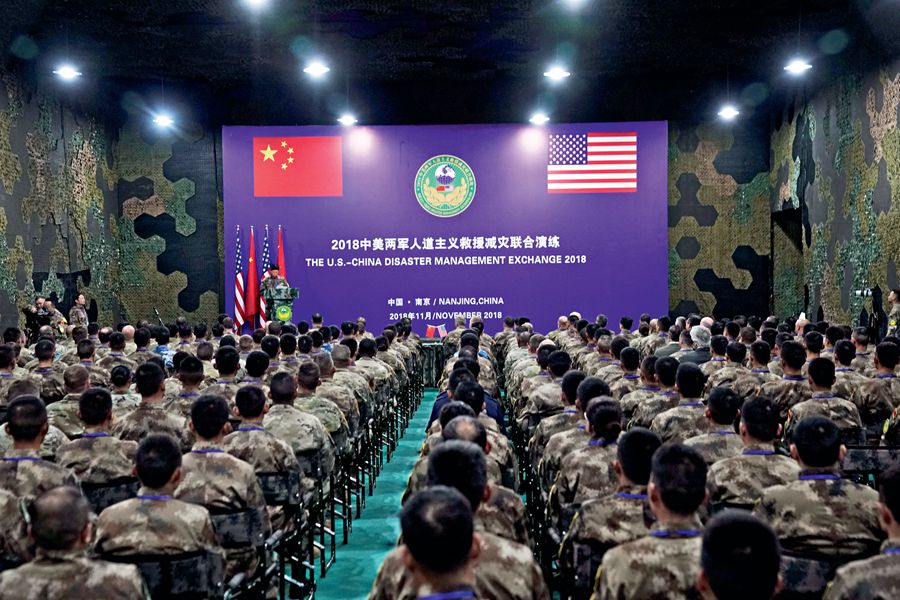THE China-U.S. relationship had been overshadowed by trade frictions in 2018 until the meeting of their leaders at the end of the year at the G20 summit, sending a glimmer of hope for bilateral relations.
Trade Frictions Dampening Bilateral Relations
When U.S. President Donald Trump took office in 2017, China-U.S. relations remained stable. Chinese President Xi Jinping met Trump at the latter’s Florida resort of Mar-a-Lago in April of the year, where the two sides committed to jointly advancing the bilateral economic and trade relations. Months later, Trump paid a state visit to China in November, during which the two sides sealed deals worth US $250 billion.

However, ominous signs already appeared in 2017. First, the “100-day action plan,” one of the fruits of the Xi-Trump meeting in Mar-a-Lago, intended to reduce trade imbalances, didn’t fare well. Then in August, Trump instructed the U.S. Trade Representative Robert Lighthizer to formally initiate an investigation of China under Section 301 of the Trade Act of 1974. On November 28, the Commerce Department self-initiated an anti-dumping duty and countervailing duty investigation of imports of aluminum sheet from China for the first time in 20 years. According to the Financial Times, on December 1, while being interviewed by the British media outlet, the U.S. Under Secretary of the Treasury for International Affairs David Malpass indicated that the U.S.-China comprehensive economic dialogue had become suspended without a plan to restart. The main reason for the suspension was China’s non-committal attitude towards key areas of U.S. concerns from the U.S. perspective.
In 2018, China-U.S. economic and trade relations deteriorated sharply. The Trump administration started to slam tariffs on imports based on its domestic laws and rules. For example, it started to impose 30 percent and 50 percent tariffs on imported solar panels and washing machines in February, and in March, tariffs of 25 percent on imported steel and 10 percent on aluminum.
The above tariffs were directed at all related countries; but the investigation under Section 301 targeted China only, and determined that acts, policies, and practices of the Chinese government related to technology transfer, intellectual property, and innovation are unreasonable or discriminatory, and burden or restrict U.S. businesses. Based on the investigation report, the U.S. released its list of approximately US $50 billion worth of Chinese imports that would be subject to additional tariffs of 25 percent. China fired back by declaring 25 percent tariffs on American imports of US $50 billion, including soybeans, cars, and planes from Boeing.

On December 1, 2018, Chinese President Xi Jinping and the U.S. President Donald Trump meet on the sidelines of the G20 Summit in Buenos Aires, Argentina.
After multiple futile negotiations, China had to adopt comprehensive counter-measures to retaliate. As the first round of additional tariffs on US $36 billion worth of Chinese goods took effect on July 6, China’s countermeasures came into force too. Meanwhile resorting to the WTO, China lodged a complaint against the U.S. unilateral imposition of tariffs on Chinese products under Section 301.
On September 17, the U.S. further declared the imposition of an additional duty of 10 percent on US $200 billion worth of Chinese products, which took effect on September 24, and was expected to increase to 25 percent on January 1, 2019. Then on September 18, China’s countermeasures targeting US $60 billion worth of American imports took effect, and China also filed another suit with the WTO against the U.S. tariffs on US $200 billion of Chinese imports. An important turn came on December 1 when leaders of the two countries met at the sidelines of the G20 Summit in Argentina with a critical consensus reached. The U.S. agreed to not increase tariffs on US $200 billion worth of Chinese imports to 25 percent. The two sides decided to start negotiations on outstanding issues and restrain from any move to escalate their trade friction.
Frictions Extended to Other Areas
Sino-U.S. trade friction is not only reflected in imposition of tariffs by both governments, but also extends to other areas and occasions. President Trump signed the National Defense Authorization Act for Fiscal Year 2019 in August 2018 passed by the Senate and the House of Representatives, which includes the Foreign Investment Risk Review Modernization Act (FIRRMA) that aims at strengthening examination of foreign investment. FIRRMA has apparently enhanced the power of the Committee on Foreign Investment in the United States (CFIUS) on foreign investment review; thus foreign investment including that from China in the United States will be subject to even stricter security review. In accordance with the bill, the CFIUS jurisdiction has been expanded to include certain joint ventures, minority-position investments, and real estate transactions near military bases or other sensitive national security facilities.
With the friction extended from economic to non-economic fields, the U.S. announced sanctions against the Equipment Development Department of China’s Central Military Commission and its leading personnel on September 21 according to its domestic law. Scholars who have participated or are participating in China’s talent projects like the Recruitment Program of Global Experts (also called the One Thousand People Plan) might not receive funding for education, academic training, or any research from the Department of Defense of the United States.

In the past year the U.S., the EU, and Japan have many times jointly released statements that are clearly aimed at China. Chinese and American ambassadors had heated debates over their respective trade policies at the WTO on May 8 and July 26, 2018. Reform of the WTO has also been put on the agenda since 2018 and has become the focus of debate.
China and the U.S. have also faced off over issues over the Korean Peninsula, Taiwan Straits, and the South China Sea in addition to economic and trade frictions. China played a big role in the easing of the North Korean nuclear crisis, and made possible the first meeting between the top leaders of the DPRK and the U.S. It also played a constructive role in inter-Korean dialogue and cooperation. That being said, the North Korea nuclear issue is one of the very few issues on which China and the U.S. cooperated on in 2018. However, the situation is not as optimistic on the Taiwan Straits and the South China Sea issues. President Trump signed the Taiwan Travel Act passed by the Congress in March in spite of protests and warnings from China, having caused a rift between the two countries again on the Taiwan issue. In addition, the U.S. continues to stir up trouble in the South China Sea. The close confrontation between Chinese and U.S. warships and the U.S. aircraft carrier intruding the South China Sea are all indicators that the political and military confrontation between China and the U.S. over the South China Sea shows little sign of abating.
Causes of Frictions
Looking back on the course of China-U.S. economic and trade frictions in 2018, we can find that the reasons for the escalation involve multiple factors. The direct cause is that the Trump administration has adjusted its trade policy. The Obama administration shifted its trade policy from multilateralism to regionalism. Trump, after assuming power, abandoned the trade policy prioritizing regional trade liberalization, and pursued bilateral negotiations and trade liberalization of trading partners, asking for more leverage. The policy laid emphasis on forcing the other party to implement trade liberalization in exchange for better treatment by the U.S. Therefore, it is not difficult to understand the Trump administration’s hardline measures to levy tariffs.

The U.S. Army and China’s People’s Liberation Army (PLA) military personnel attend a closing ceremony of an exercise of Disaster Management Exchange near Nanjing, Jiangsu Province in November 2018.
The contention between China and the United States has expanded from the trade sphere to the whole economic domain, even to the North Korean nuclear issue, Taiwan issue, South China Sea, and other fields. The deep-seated reason lies in the perceived rivalry between the two leading powers. After the Trump administration came into power, the U.S. policy towards China became increasingly distinct. Its National Security Strategic Report explicitly listed China and Russia as rivals. The Trump administration’s White House team is mostly comprised of hawks, unfriendly to China, which also illustrates this point. Trump’s administration deems that the primary cause for China’s rise and progress lies in its unique institution, which is beneficial to itself and unfavorable to the United States, and will ultimately enable China to catch up with and surpass the United States. The Trump administration, based on this, hopes to contain China through establishing new rules, thus enabling the United States to achieve an advantage in competition.
A Better Future Expected
Looking ahead to the economic and trade relations between China and the United States in 2019, although there are still uncertainties, cautious optimism may be the best attitude. After the meeting between heads of China and the United States, there will be a 90-day deadline between the two sides to resolve mutual concerns through negotiations. Bilateral negotiations, whether for the United States or China, will still be the only way to resolve their economic and trade frictions. The Trump administration, despite its tough rhetoric, expressed willingness to negotiate with China after the meeting between the heads of both states, demonstrating that it was in its interest to negotiate rather than impose tariffs. However, the outcome of the negotiations will be affected by factors including the relatively short 90-day period and the willingness of both sides to compromise. There are reasons to maintain optimistic, but the optimism needs to be cautious.
SU QINGYI is a senior research fellow and deputy director of the Department of International Trade at the Institute of World Economics and Politics (IWEP), Chinese Academy of Social Sciences (CASS).



